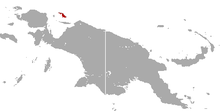| Blue-eyed spotted cuscus | |
|---|---|
| Conservation status | |
 Critically Endangered (IUCN 3.1) | |
| Scientific classification | |
| Domain: | Eukaryota |
| Kingdom: | Animalia |
| Phylum: | Chordata |
| Class: | Mammalia |
| Infraclass: | Marsupialia |
| Order: | Diprotodontia |
| Family: | Phalangeridae |
| Genus: | Spilocuscus |
| Species: | S. wilsoni |
| Binomial name | |
| Spilocuscus wilsoni Helgen & Flannery, 2004 | |

| |
| Blue-eyed spotted cuscus range | |
The blue-eyed spotted cuscus or Biak spotted cuscus (Spilocuscus wilsoni) is a species of critically endangered marsupial in the family Phalangeridae.
Taxonomy
The blue-eyed spotted cuscus is one of five species of spotted cuscus in the genus Spilocuscus.
Description
The blue-eyed spotted cuscus has a pale marbled coat with shades of brown, grey, and white with a creamy white underbelly. This species is relatively smaller in size than the other Spilocuscus cuscuses and has distinct pale blue eyes.
Distribution and habitat
The blue-eyed spotted cuscus can be found on several of the islands in the Cenderawasih Bay in West Papua of Indonesia. This region is made up of the islands Biak, Supiori, and Numfor. Despite being endemic to the islands Biak and Supiori, the blue-eyed spotted cuscus have been spotted on the island of Numfor as pets. This cuscus lives in the treetops of the tropical rainforests found throughout Supiori and Biak. Due to the rugged terrain common on the Supiori Island, it is better insulated from human foot traffic and allows for a more flourishing population than that on Biak.
Conservation
The major threats to the blue-eyed spotted cuscus include habitat loss, hunting, and collection for the exotic pet trade by locals. Due to its rarity, the blue-eyed spotted cuscus was only scientifically described in 2004 and was deemed critically endangered by the IUCN in 2015. Recent surveys have failed to find any wild individuals from Numfor and, more recently, Biak.
Currently, there are no widespread conservation efforts dedicated to protecting this species. However, 12% of its ecoregion (344km) has been classified as protected between the three islands.
References
- Aplin, K.; Helgen, K. (2016). "Spilocuscus wilsoni". IUCN Red List of Threatened Species. 2016: e.T136443A21950078. doi:10.2305/IUCN.UK.2016-2.RLTS.T136443A21950078.en. Retrieved 12 November 2021.
- ^ "Blue-eyed Spotted Cuscus". Asian Species Action Partnership. Retrieved 2022-04-24.
- IUCN (2015-06-15). "Spilocuscus wilsoni: Aplin, K. & Helgen, K.: The IUCN Red List of Threatened Species 2016: e.T136443A21950078". doi:10.2305/iucn.uk.2016-2.rlts.t136443a21950078.en.
{{cite journal}}: Cite journal requires|journal=(help) - "Places | Conserving Priority Places". World Wildlife Fund. Retrieved 2022-04-24.
| Taxon identifiers | |
|---|---|
| Spilocuscus wilsoni | |